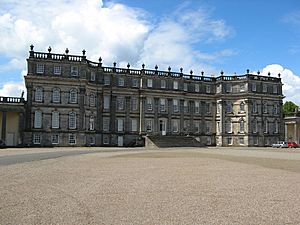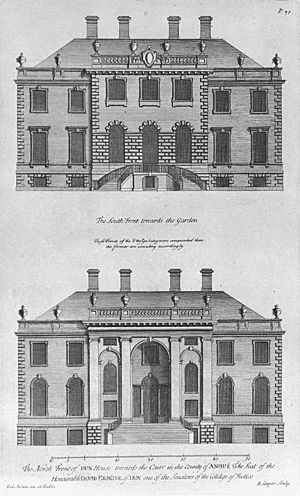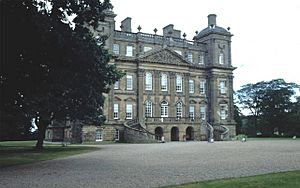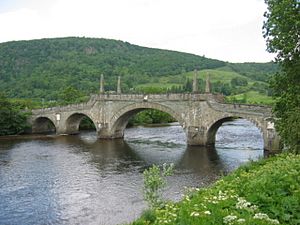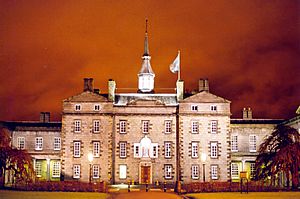William Adam (architect) facts for kids
Quick facts for kids
William Adam
|
|
|---|---|
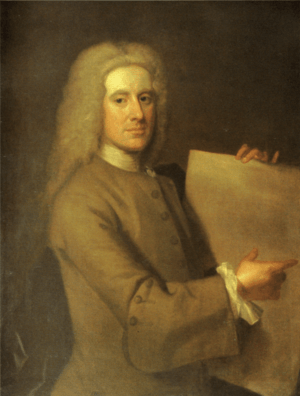
Portrait by William Aikman, 1727
|
|
| Born | October 1689 |
| Died | 24 June 1748 (aged 58) |
| Occupation | Architect |
| Buildings | Hopetoun House Mavisbank House Arniston Duff House Pollok House |
| Projects | Inveraray Castle |
William Adam (born in 1689 – died June 24, 1748) was a very important Scottish architect, stonemason, and businessman. He was the most famous architect in Scotland during his time. He designed and built many large country homes and public buildings. He often worked as the contractor (the person who manages the building work) as well as the architect.
Some of his most famous buildings include Hopetoun House near Edinburgh and Duff House in Banff. His unique and lively style was based on the Palladian style, which uses ideas from ancient Roman and Greek buildings. But he also added Baroque details, which are grand and dramatic, inspired by architects like Vanbrugh and European designs.
In the 1700s, people called Adam Scotland's "Universal Architect" because he could do so many things. Besides being an architect, Adam was involved in many businesses. These included coal mining, making salt, running stone quarries, and mills. In 1731, he started building his own large property in Kinross-shire, which he named Blair Adam. He had three sons who also became architects: John, Robert, and James. Robert and James later created their own famous "Adam style" of architecture.
Contents
Biography
Early Life and Training
William Adam was born in Linktown of Abbotshall, which is now part of Kirkcaldy, Fife. He was baptized on October 24, 1689. He was the only child of John Adam, who was a mason (a person who works with stone), and Helen Cranstoun. William likely went to school in Kirkcaldy until he was 15. After that, he probably learned how to be a mason from his father.
Some people think Adam learned from Sir William Bruce, another famous architect, at Kinross House. However, the dates don't quite fit. It's more likely he learned at Hopetoun House, which Bruce was building around that time. By 1717, Adam was a skilled mason. Before 1720, he traveled to France and the Netherlands. He visited country houses and saw the canal at Ostend, learning new ideas.
In 1714, Adam started a business with William Robertson, a local landowner. They set up a brickworks in Linktown. This business was very successful. Adam is known for bringing the making of Dutch pantiles (a type of roof tile) to Scotland. On May 30, 1716, Adam married Mary, William Robertson's daughter. They moved into her family's home, Gladney House.
Becoming Famous
It's not fully known how William Adam became such a successful architect. But by 1721, he was working on big projects. He worked on Floors Castle, where he used a design by Vanbrugh. He also designed additions to Hopetoun House. At this time, another important architect, James Smith, was getting older and retiring. Like Smith, Adam was a trained mason, had good social connections, and had money from his successful businesses. In 1721, Adam also became a Freemason.
Unlike some architects who were Episcopalian (a different church group), Adam was a Presbyterian Whig. At that time, the Whig party was in power in Britain. Episcopalians were sometimes linked to Jacobitism (supporting the old royal family), which was not popular with the new rulers. Adam's beliefs were more accepted. This helped him get important supporters like John Dalrymple, 2nd Earl of Stair and Sir John Clerk of Penicuik. These powerful men were his clients and tried to get him government jobs. For example, in 1728, he became Clerk and Storekeeper of the King's Works in Scotland. In 1730, he became the main Mason for the Board of Ordnance in North Britain, which meant he worked on military buildings.
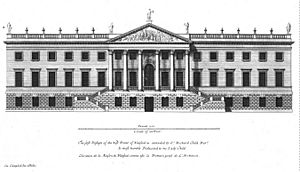
In 1727, Adam and Sir John Clerk traveled to London. They visited many country estates like Cliveden and Wanstead House. In London, Adam tried to make more political connections. He also looked for someone to engrave drawings for his planned book of architectural plans, which would later be called Vitruvius Scoticus. While there, he had his portrait painted by William Aikman.
His Busy Life
By 1728, Adam was a very successful architect with many businesses. These included coal mining, making salt, quarrying stone, and improving farms. On February 21, 1728, Adam became a burgess (a citizen with special rights) of Edinburgh. He moved his family to a property there.
His business activities kept growing. Since working on Hopetoun in 1721, he had rented quarries near Queensferry to get stone for his buildings. From 1734, he rented storage spaces in Leith. He also rented coal mines and salt pans at Cockenzie. Later, he built a canal (1742–44) to help with the mines. His main focus from 1731 was Blair Crambeth, a large property in Kinross-shire that he bought. He renamed it Blair Adam and worked on making it better, planting trees, fencing land, and starting coal mines. He even created a village called Maryburgh for the miners.
Later Years
In 1741, Adam had to go to court against William, Lord Braco. This was to get paid for his work at Duff House. There was no formal agreement, and they disagreed on the cost of the carved stone. The case was not fully settled until just before Adam died.
After the Jacobite rising of 1745 (a rebellion), Adam's job as Mason to the Board of Ordnance gave him many big military building jobs in the Highlands. By 1746, his three oldest sons were working in the family business. James and John left Edinburgh University early to join their father.
William Adam became ill in late 1747 and died the next summer. He was buried in Greyfriars Kirkyard, Edinburgh. His son John designed the family tomb built in 1753. This tomb was repaired in 1997 to mark 250 years since his death.
Architectural Works

Adam used many different ideas for his designs and created his own unique style. He was mainly influenced by English Palladianism, which is a classical style. Many of his houses look like designs from Colen Campbell's book Vitruvius Britannicus. But Adam also mixed in grand English Baroque ideas from architects like Gibbs and Vanbrugh. He used many design books from France, Italy, and England. He also got ideas from older Scottish buildings and from architects who came before him, like Bruce and Smith. During his almost 30 years as an architect, Adam designed, added to, or changed over 40 country houses. He also worked on many public buildings. He even designed gardens, for example at Newliston and Taymouth Castle.
Country Houses
His first big job was adding to Hopetoun House, near Edinburgh. This house had been built only 20 years before by Sir William Bruce. Adam was hired to rebuild the south-east wing. These changes, finished in 1725, gave the east side a bold new look with curved sections. One expert said that "nothing so ambitious or imaginative had ever before been attempted in Scotland." Over the years, Adam kept working on Hopetoun, building the south walkway from 1726, the north wing from 1728, and the side buildings from 1736. These were finished in 1742. Adam's sons completed the whole project after his death. Adam also designed the gardens, possibly using ideas from Bruce.
Other early designs included Drum House, which had Scotland's first venetian window (a large window with three parts). He also designed Mavisbank, both near Edinburgh. Mavisbank House, built between 1723 and 1727, was the first Palladian villa (a grand country house) in Scotland. Adam worked on it with the owner, Sir John Clerk, who was also an amateur architect. Adam's most ambitious early work was the grand, Baroque-style Arniston, near Gorebridge. Built for Robert Dundas, a lawyer, Arniston included large grounds designed by Adam with gardens and a waterfall.
Duff House, Adam's main work in the 1730s, shows how he combined local and foreign ideas. It looks like "a medieval castle in baroque dress." Built between 1735 and 1739, Adam was both the builder and the architect for William, Lord Braco. The main front of Duff House is very tall, and with its tall corner towers, the house looks very vertical. This style is similar to designs by the exiled Earl of Mar, who worked with Adam on the House of Dun. Duff House is compared to 17th-century Drumlanrig Castle and fits into Scottish architectural traditions. The "baroque dress" at Duff comes from Vanbrugh. Plans for other parts of the house were never built because of a disagreement between Lord Braco and Adam.
Adam's other houses from the 1730s include House of Dun in Angus, Tinwald in Dumfriesshire, and Haddo House in Aberdeenshire. His early design for House of Dun, working with the Earl of Mar, is interesting. It shows a traditional tall Scottish tower house with spiral stairs inside, but with classical details on the outside. Adam clearly took ideas from traditional Scottish buildings. Chatelherault, the Duke of Hamilton's hunting lodge near Hamilton, was finished in 1743. Adam also redecorated the Duke's apartment in Holyroodhouse, which was his most important interior design job.
After 1740, Adam built only two more houses: Cumbernauld House and Cally House. From 1746, Adam was overseeing the building of Inveraray Castle, which was designed in a Gothic style by Roger Morris. Adam also helped plan the new town at Inveraray. His last architectural work was for Lord Lovat in 1744, for a new house at Castle Dounie. But the house was never built because Lord Lovat was involved in the Jacobite rising of 1745.
Public Buildings
Adam's first public building jobs were in Aberdeen. He built the town hall there from 1729–30 (now gone) and Robert Gordon's Hospital from 1730–32 (now a school). The original Edinburgh Royal Infirmary on Infirmary Street was a grand building designed by Adam in 1738. It was one of the first hospitals in the world. Adam also built George Watson's Hospital in Edinburgh from 1738–41 (now gone). In 1745, William Adam's "New Library" for the University of Glasgow was finished (also now gone). Adam's town hall for Dundee is also gone, and the one in Haddington has been changed a lot. Adam built only one church, Hamilton Old Parish Church, in 1733.
The last Jacobite rising happened in 1745. After this rebellion, the government made the Highlands more military. Adam's work for the Ordnance Board (military building group) increased a lot. He and his sons worked on forts like Fort Augustus, Fort William, and Fort George near Inverness. They also worked on castles like Dumbarton, Stirling, and Edinburgh.
Vitruvius Scoticus
In the 1720s, Adam planned to publish a book of architectural drawings of Scottish houses. This included his own work and that of others. His book, Vitruvius Scoticus, was named after Colen Campbell's Vitruvius Britannicus. He had some drawings engraved during his 1727 trip to London. The project then stopped, possibly because not enough people signed up to buy it. The book was finally published in 1812 by John's son, William. It contained 160 drawings, including 100 of Adam's own designs.
Legacy
William Adam was very important in Scottish architecture because there were few other architects as skilled as him at the time. One expert wondered "whether Scottish architecture at this period... would have achieved very much without him."
Adam's death happened around the same time the Jacobite threat ended in 1746. New building styles became popular, like Neoclassicism (a new classical style) and the "castle" style, which led to the Scottish baronial style (a style that looks like old Scottish castles). Adam was a practical builder, not a theorist, so he didn't create a strong style that directly influenced future designs.
His most important gift to architecture was his three architect sons, especially Robert Adam. Robert's success with the "Adam Style" was even greater than his father's. Robert developed his own style after studying in Rome. However, his father's influence can be seen in all three brothers' work. Working with their father gave the brothers a strong understanding of how to build things. It also introduced them to important clients they might not have met otherwise.
How People See His Work
Even though people in his time praised Adam's "genius for architecture," some modern experts have found his work to be of mixed quality. In the 1700s and 1800s, he was seen as Scotland's "Universal Architect."
In the 1900s, people started to look at Adam's work more critically. Some said he was "a rather ordinary classical architect" or that his work was "heavy and ordinary." However, others point out that Adam should be seen as "the architect of Scotland." They say his work was "robust and direct," which fit the artistic mood of North Britain at the time.
Many experts agree that Adam was at his best when he worked with others. He "was at his best when guided by a man of taste who knew his own mind." This means he did his best work when he was not only using his design books but also working with other creative people.
Family
William Adam and Mary Robertson had ten children who lived:
- Janet ("Jenny") (born 1717): She later helped manage her brothers' business in London.
- John (born July 3, 1721): He took over the family businesses and also worked as an architect.
- Robert (born July 3, 1728): A famous architect and the best known of the Adam brothers.
- James (born July 21, 1732): An architect and Robert's business partner.
- William ("Willie") (born 1738)
- Elizabeth ("Betty"): With Janet, she managed her brothers' London business.
- Helen ("Nellie")
- Margaret ("Peggy")
- Mary: She married Rev John Drysdale, a minister.
- Susannah: She married Sir John Clerk of Eldin, who was the son of Sir John Clerk of Penicuik.
After William Adam died, his oldest son John took over the family business. He immediately brought his brothers Robert and James into the business. This partnership lasted until the late 1750s when Robert started his own work in London. William Adam's obituary (a notice of his death) said that "it is fortunate he has left behind him some promising young men to carry on what he has so happily begun." John Adam passed Blair Adam on to his own son, William Adam, a lawyer and politician. His family still owns the estate today.
|
See also
 In Spanish: William Adam (arquitecto) para niños
In Spanish: William Adam (arquitecto) para niños


